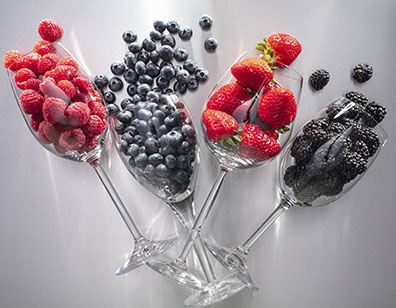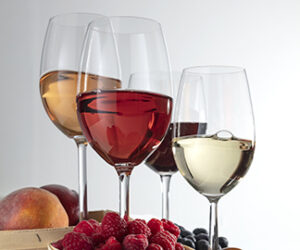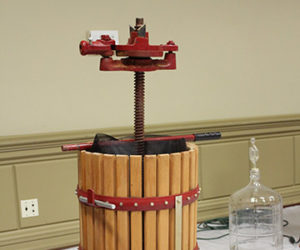
What defines a berry is akin to what constitutes a vegetable. There are two definitions, the botanical one and the traditional classifications. Take, for example, raspberries, blackberries, and strawberries; three iconic berry fruits grown in temperate climates . . . and it turns out none of them are truly berry fruits. But winemakers don’t really care about botanical definitions, much like tomatoes are still called vegetables by many in the culinary world. So for the sake of this column, many soft-skinned, pit-less fruits like those listed earlier still fall under the umbrella of berries.
So What About the Berries
Berry wines are commonly made in areas where Vitis vinifera and other wine grapes struggle to thrive. Even many grape growing regions also offer an array of fruits available for winemaking purposes. Fruits like currants, salmonberries, juneberries, gooseberries, bearberries, chokecherries, and cranberries . . . there are an abundance of berry fruits growing around the world that can be processed into wine. Berry wines are also a great option for home winemakers living where grapes are prevalent because they often ripen outside of the grape harvest timeframe; giving winemakers another season to enjoy their hobby.
Processing Berry Fruit
Not everyone can harvest and process the amount of fruit required to produce a mid-sized, say a 5-gallon (19-L), batch of wine. There are plenty of alternatives including frozen fruit, purees, juices,
and concentrates that are available for purchase if a larger volume is desired. Supplementing two or more of these options may actually be a good solution as they can provide different fruit character. Also, blending with grape wine may be a great solution when certain characteristics in a grape wine need a boost. Blueberries in a Pinot Noir or strawberries in a Grenache rosé can prove to be fun, highly drinkable porch sippers.
A key for almost any of the traditional berry fruit wines is breaking down the cell walls of the fruit. Freezing the fruit prior to maceration is one common technique that many berry winemakers employ. The addition of pectic enzymes can also be helpful. Pectins are in the sugar family (polysaccharides) and can cause a haze in the final wine. Adding an enzyme meant to chop these polysaccharides can actually have a two-fold solution: They can break down one of the key problematic haze-causing compounds and can also increase your yield. If you’re using fresh-picked or frozen fruit, a little pectic enzyme can go a long way in crafting a stable wine.
Chaptalization and Acidity
It’s impossible to talk about berry wine production and not also discuss the need for chaptalization and for a possible acidification or deacidification as well. If you stick with typical grape wine parameters then producing a stable berry fruit wine is attainable. Starting with a sugar addition to chaptalize up to 22 °Brix is safest. Most recipes you will find call for between 2.5–5 lbs. of berry fruit per gallon (0.3–0.6 kg/L) of finished wine. The more fruit means more fruit character, less water needed, and more acidity. Starting sugar concentrations and acid levels depend upon the fruit type and variety, its growing season, and harvest date.
Targeting a pH level between 3.3–3.6 is a good goal. While there are a few exceptions, citric acid is typically the largest organic acid component in berry fruits. Winemakers should note citric acid, like malic acid, is susceptible to metabolic degradation. Also, high acidity can be counterbalanced with backsweetening.
Strawberry
A key component of strawberry wine is coaxing the flavor from the berries while retaining that character and color. The pigments that color strawberries are not that robust and prone to oxidative degradation. Adding some crushed red grapes or red grape concentrate can provide a more stable rosé hue. Strawberry wines are often crafted with a sweet character, but they don’t need to be, and actually can be quite delicious when dry. Look for fruit that has received a great deal of sun exposure, allowing them to gain that vibrant red hue from anthocyanins.
In standard greenhouse-grown strawberries you may find sugar at 9 °Brix, which should provide a great base for a strawberry wine. With the TA at 9 g/L or higher, water dilutions may require an acid addition if pH started high. Sometimes a little strawberry flavoring extract can really make the wine pop.
Blueberry
One of the great aspects of blueberries is the polyphenolic load found in their skins that are close to typical wine grapes. These compounds will help provide color and structure to blueberry wine. Blueberries are fairly high in sugar with ripe, high-quality fruit coming in at 14–18 °Brix. Some red grape concentrate can be added to enhance the fruitiness and bring Brix up to a more common wine range.
Raspberry
Raspberries can come in both red and black form and both can be utilized for winemaking. Freezing the berries prior to working with them is a great help to pulverize each berry. Expect them to ripen to 8–13 °Brix with a TA between 10–20 g/L. Also note that pressing raspberries can be a challenge due to their mushy character at this point. Go slow or add rice hulls to separate the juice from pulp.






